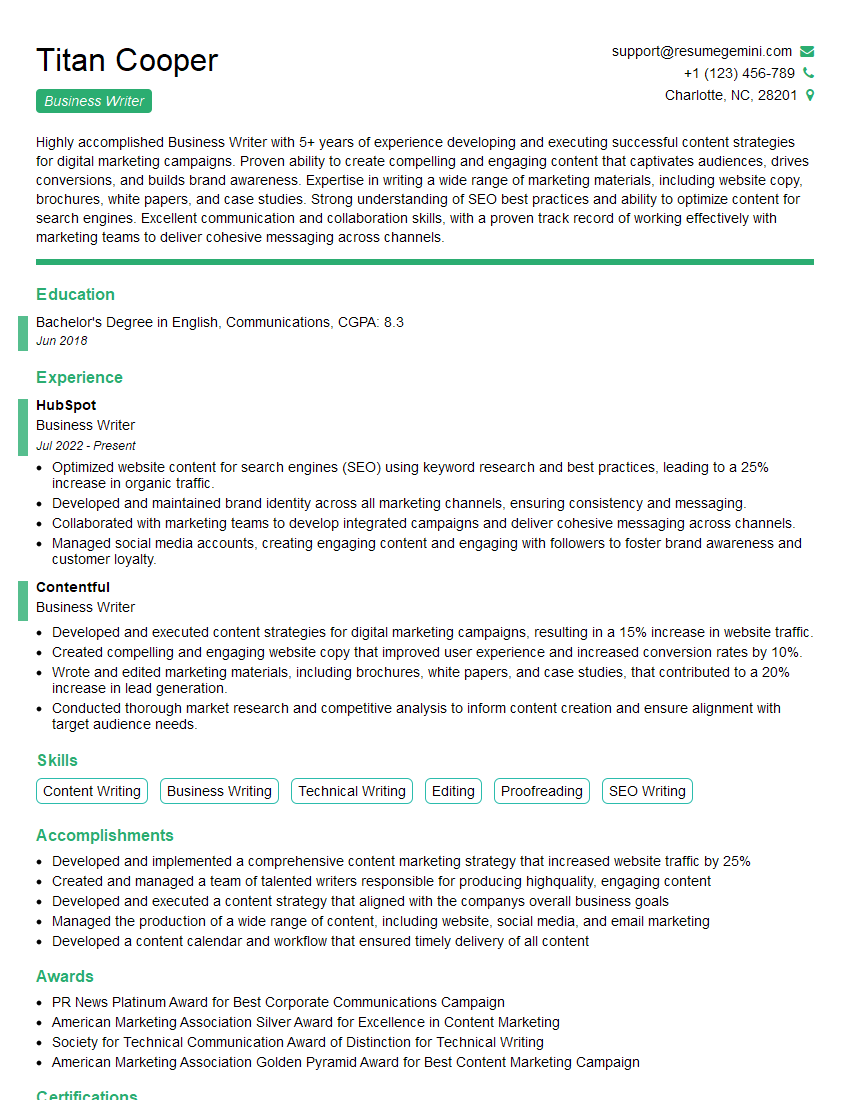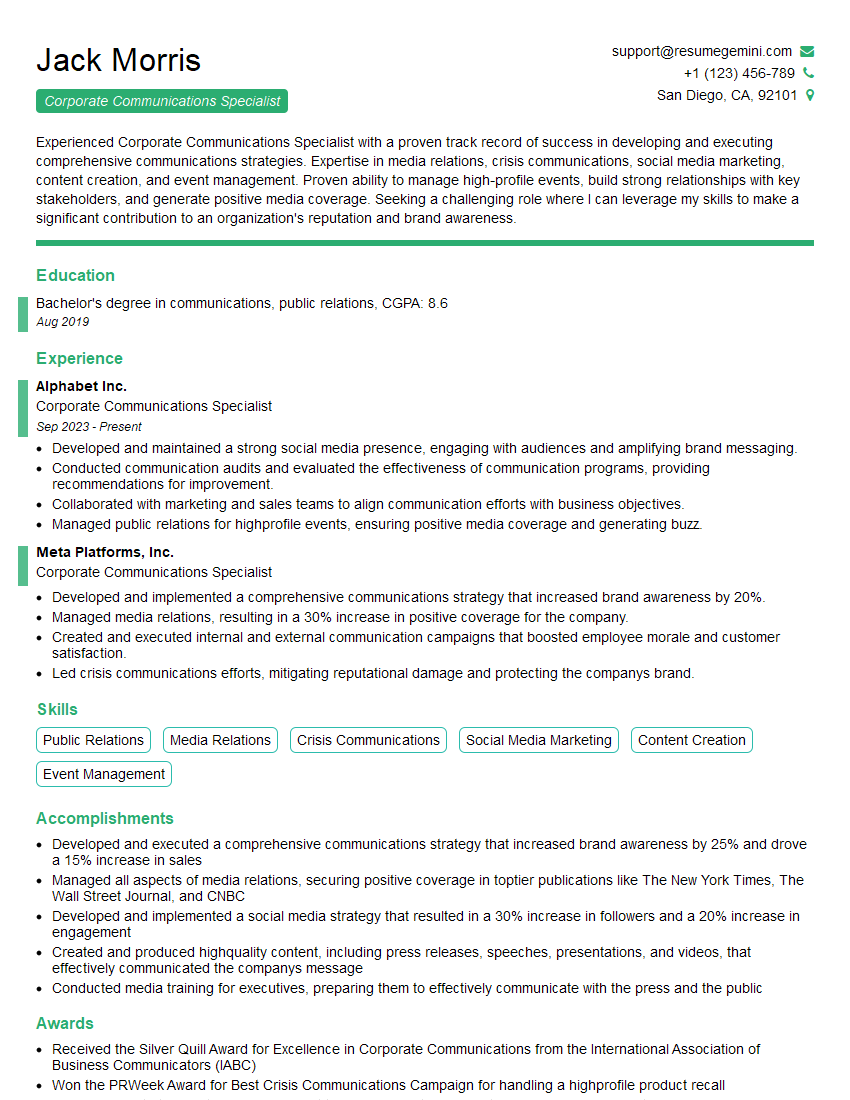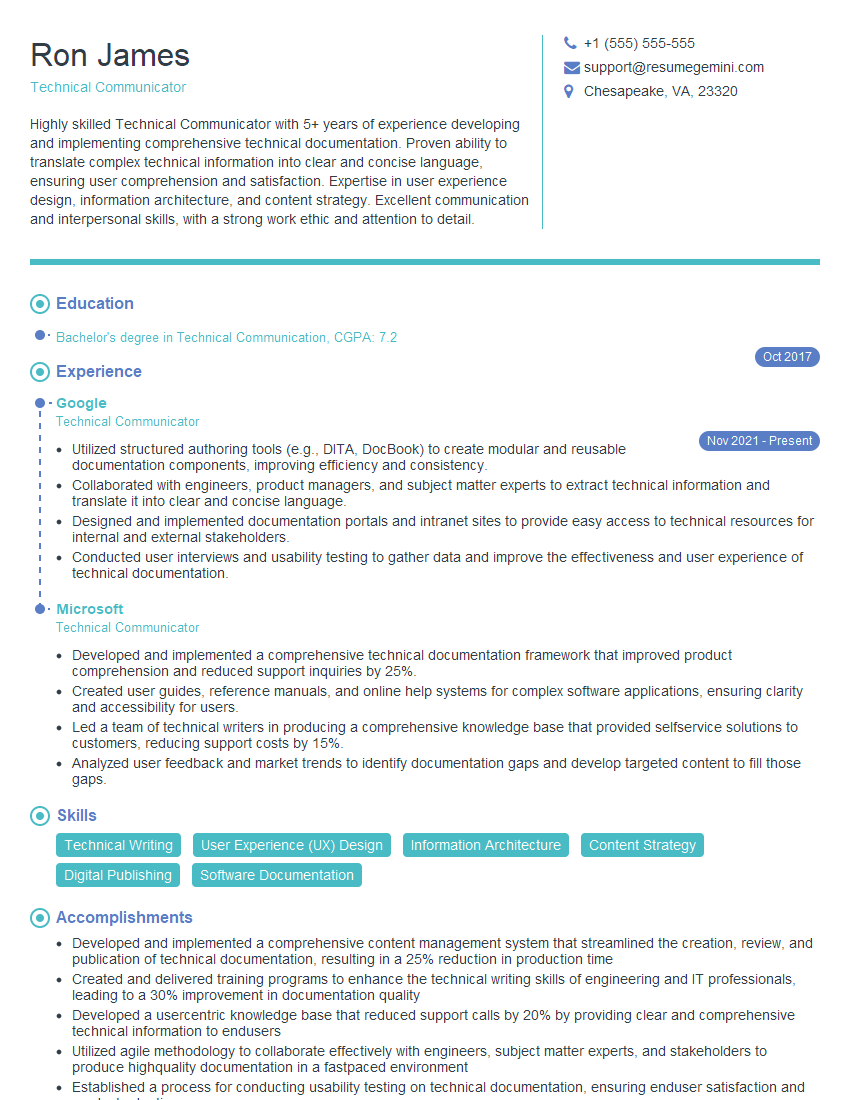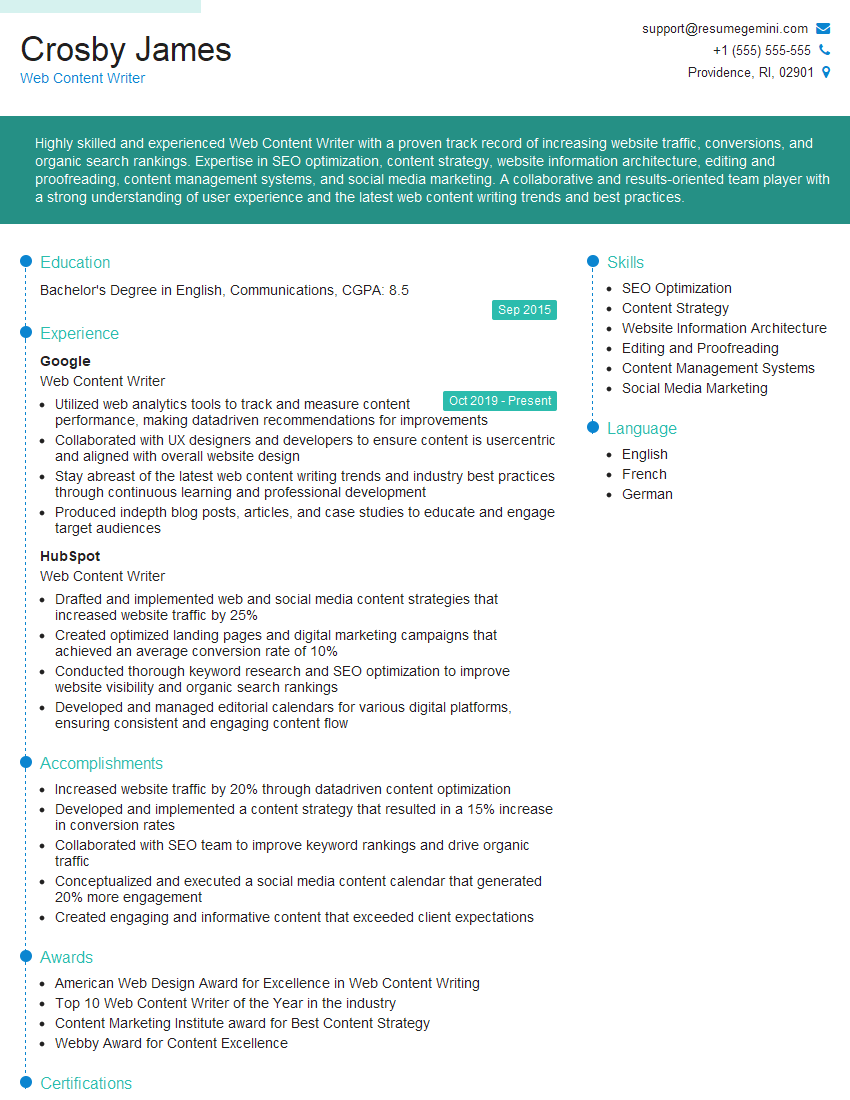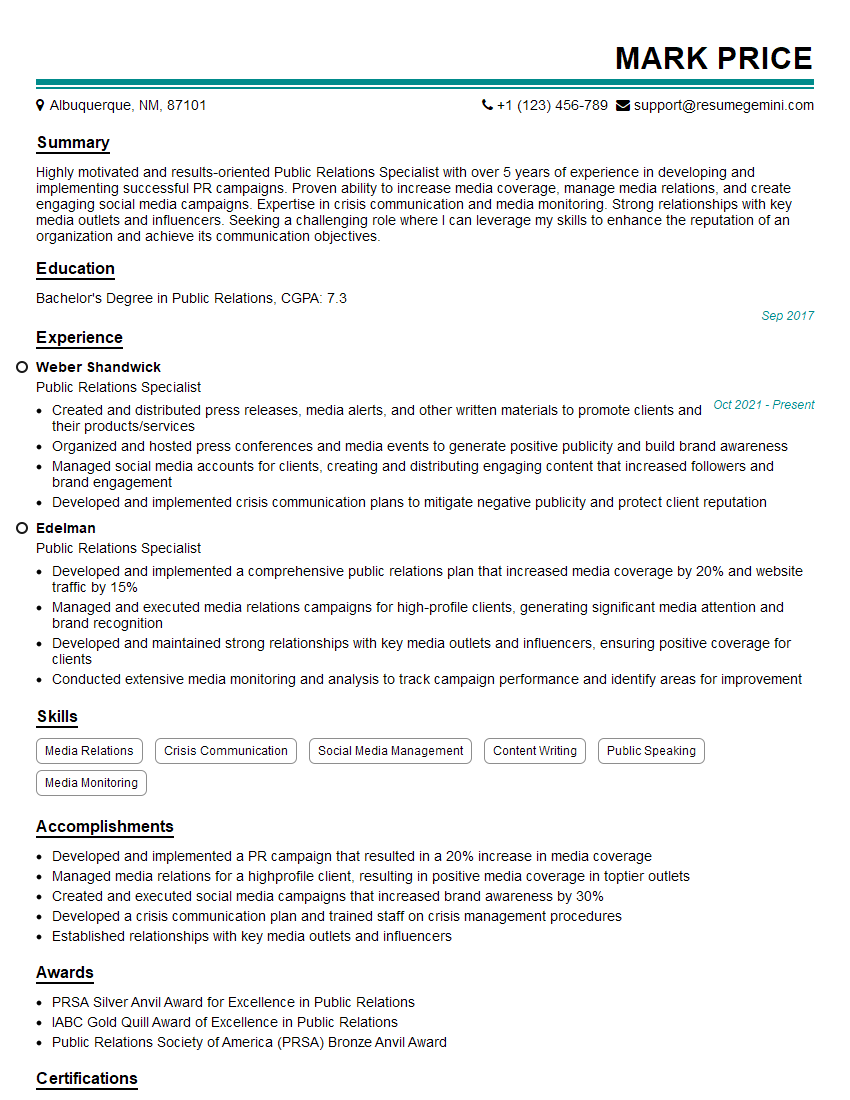Cracking a skill-specific interview, like one for Writing for Different Purposes, requires understanding the nuances of the role. In this blog, we present the questions you’re most likely to encounter, along with insights into how to answer them effectively. Let’s ensure you’re ready to make a strong impression.
Questions Asked in Writing for Different Purposes Interview
Q 1. Explain the difference between copywriting and content writing.
While both copywriting and content writing involve crafting written material, their primary goals and approaches differ significantly. Think of it this way: copywriting focuses on immediate conversion, while content writing aims for broader engagement and brand building.
Copywriting is persuasive writing designed to drive a specific action, such as making a purchase, signing up for a newsletter, or clicking a link. It’s often short, punchy, and highly targeted to a specific audience. Examples include website headlines, social media ads, and product descriptions. The goal is to elicit an immediate response.
Content writing, on the other hand, aims to inform, educate, or entertain the audience. It focuses on providing value and establishing thought leadership. Examples include blog posts, articles, white papers, and website content. The goal is to build trust, establish authority, and foster long-term relationships with readers.
In essence, copywriting is transactional, while content writing is relationship-oriented.
Q 2. Describe your experience adapting your writing style for different audiences.
Adapting my writing style to different audiences is a crucial part of my process. I consider factors like age, education level, technical expertise, and cultural background when choosing my tone, vocabulary, and sentence structure. For instance, a technical white paper for data scientists would use precise jargon and complex sentence structures, while a blog post for a general audience would prioritize simplicity and clarity, avoiding specialized terminology.
I’ve worked on projects ranging from crafting engaging social media posts for teenagers to writing comprehensive technical documentation for software engineers. In each case, I’ve consciously tailored my approach to resonate with the specific target audience. I regularly review my work, analyzing the readability and ensuring the message aligns with the audience’s understanding and interests. A successful adaptation leads to better comprehension and engagement.
Q 3. How do you ensure accuracy and clarity in your writing?
Accuracy and clarity are paramount in my writing. I employ a multi-step process to ensure both. First, I meticulously research my topic, verifying information from reputable sources. I cross-reference data and utilize fact-checking tools to minimize errors. Second, I write clearly and concisely, avoiding jargon or overly complex sentence structures. I prioritize active voice and use strong verbs to enhance readability. Finally, I conduct thorough self-editing and proofreading, often using checklists and style guides to maintain consistency and accuracy.
For example, when writing about scientific findings, I always cite my sources and use precise language to avoid misinterpretations. Similarly, when crafting marketing materials, I ensure all claims are verifiable and avoid misleading statements. This commitment to accuracy and clarity builds credibility and trust with my readers.
Q 4. What editing tools and techniques are you proficient in?
I am proficient in a range of editing tools and techniques, both technological and manual. My go-to tools include Grammarly for grammar and style checks, ProWritingAid for in-depth writing analysis, and Hemingway Editor for readability assessment. Beyond these digital tools, I utilize various manual techniques such as reading my work aloud to catch awkward phrasing, using style guides to ensure consistency, and peer review to gain fresh perspectives.
My editing process involves multiple passes, each focusing on a different aspect, such as grammar, style, clarity, and flow. I believe in the iterative nature of editing, refining and polishing until the writing is both accurate and engaging.
Q 5. How do you handle feedback on your writing?
I view feedback as an invaluable opportunity for improvement. I approach feedback constructively, considering the source and the context. I actively listen to the feedback, ask clarifying questions if needed, and then carefully review my work to assess the validity of the suggestions. I don’t take feedback personally; instead, I treat it as a chance to enhance my writing.
My response to feedback often involves a dialogue with the provider, explaining my rationale for certain choices and demonstrating my willingness to incorporate helpful suggestions. If I disagree with a specific point, I respectfully explain my reasoning and offer an alternative solution. This collaborative approach ensures that the final product is the best possible version.
Q 6. Describe your process for researching and outlining a complex document.
My process for researching and outlining a complex document is methodical and thorough. It begins with a deep dive into the subject matter. I utilize a variety of research methods, including academic journals, reputable websites, interviews with experts, and primary source materials. I meticulously document my sources to maintain accuracy and avoid plagiarism.
Once research is complete, I create a detailed outline. This outline is not simply a list of topics but a structured framework that organizes the information logically, ensuring a clear flow of ideas. I typically employ a hierarchical structure, breaking down the main topic into subtopics and supporting points. This detailed outline serves as a roadmap during the writing process, preventing me from getting lost in tangents and ensuring a cohesive final product.
Q 7. How do you ensure your writing is SEO-optimized?
SEO optimization is an integral part of my content creation process. I begin by identifying relevant keywords through keyword research tools and analyzing competitor content. These keywords are strategically integrated into my writing, focusing on natural language and avoiding keyword stuffing. I optimize title tags, meta descriptions, and header tags (H1, H2, etc.) to enhance search engine visibility.
Beyond keyword optimization, I focus on creating high-quality, engaging content that satisfies user intent. This includes using clear and concise language, structuring the content logically, and including relevant images and multimedia. Regularly reviewing and updating content based on analytics data helps in refining the SEO strategy for better search engine rankings and user engagement.
Q 8. What experience do you have with different content formats (e.g., blog posts, white papers, case studies)?
My experience spans a wide range of content formats, each requiring a distinct approach. For example, blog posts demand concise, engaging writing that quickly grabs the reader’s attention and delivers valuable information. I’ve written numerous blog posts on topics ranging from digital marketing strategies to the latest advancements in artificial intelligence, always focusing on SEO optimization and clear calls to action. White papers, on the other hand, require a more formal, in-depth analysis, often presenting research findings and data-driven conclusions. I’ve developed several white papers exploring complex business challenges and proposing evidence-based solutions. Finally, case studies necessitate a compelling narrative showcasing a successful project or initiative, highlighting the problem, solution, and positive outcomes. I’ve crafted case studies that effectively demonstrate the value proposition of various products and services. Each format presents unique challenges; the key is adapting the style and structure to meet the specific needs of the audience and purpose.
Q 9. How do you manage multiple writing projects simultaneously?
Managing multiple writing projects simultaneously requires a structured and organized approach. I utilize project management tools like Trello or Asana to track deadlines, assign priorities, and monitor progress. I break down large projects into smaller, manageable tasks, creating a detailed timeline for each. I prioritize tasks based on urgency and importance, ensuring that time-sensitive projects receive the necessary attention. Effective time management techniques, such as the Pomodoro Technique, help maintain focus and prevent burnout. Regular communication with clients or stakeholders is crucial to ensure alignment and address any emerging issues promptly. Finally, I consistently review my schedule and adjust priorities as needed to maintain balance and efficiency. Think of it like conducting an orchestra; each instrument (project) requires careful attention to blend harmoniously and achieve the final masterpiece (successful completion of all projects).
Q 10. Describe your experience working with content management systems (CMS).
I have extensive experience with various Content Management Systems (CMS), including WordPress, Drupal, and Joomla. My familiarity extends beyond basic content entry; I’m proficient in using CMS features such as template customization, plugin integration, and SEO optimization. For instance, I’ve utilized WordPress plugins to enhance site functionality, improving user experience and search engine rankings. My understanding of CMS architecture allows me to troubleshoot issues efficiently and ensure seamless content delivery. I’ve also worked with headless CMS platforms, demonstrating adaptability to the latest technologies. Essentially, I view a CMS as a powerful tool, and my expertise allows me to leverage its capabilities to create and manage high-quality content effectively.
Q 11. How do you measure the effectiveness of your writing?
Measuring the effectiveness of my writing relies on a combination of quantitative and qualitative metrics. Quantitative metrics might include website traffic, engagement rates (time on page, bounce rate), social media shares, and lead generation. For example, an increase in website traffic after publishing a blog post indicates successful content marketing. Qualitative metrics include client feedback, reader comments, and overall brand sentiment. Analyzing reader feedback can provide valuable insights into areas for improvement. Ultimately, the effectiveness of my writing is judged by its ability to achieve the intended goals, whether it’s increasing brand awareness, driving sales, or educating the target audience. It’s a data-driven approach, constantly refined based on performance analysis.
Q 12. What is your approach to writing for a specific tone or style guide?
My approach to writing for a specific tone or style guide is methodical and detail-oriented. I begin by thoroughly reviewing the style guide, paying close attention to vocabulary, sentence structure, and overall voice. I then immerse myself in the brand’s messaging and target audience to understand their preferences and expectations. I utilize the style guide as a reference point throughout the writing process, ensuring consistency and accuracy. I often use a checklist to track adherence to style guidelines, helping to maintain consistency across different projects. This structured approach allows me to adapt my writing style effectively, ensuring the final product aligns perfectly with the brand’s identity and communication objectives. Adaptability is key; one size does not fit all when it comes to tone and style.
Q 13. How familiar are you with AP style or Chicago Manual of Style?
I’m proficient in both AP style and Chicago Manual of Style, understanding their nuances and applications. AP style is particularly useful for journalistic writing and press releases, prioritizing brevity and clarity. Chicago style, on the other hand, is more commonly used in academic and scholarly writing, emphasizing precision and detailed citation. My understanding extends beyond just the basic rules; I can effectively apply them to different contexts, ensuring the accuracy and consistency of my writing. Choosing the right style guide depends on the context and intended audience; knowing both allows me to select the most appropriate style for each project.
Q 14. Describe your experience writing for different digital platforms (e.g., websites, social media).
My experience encompasses writing for various digital platforms, each with its unique characteristics. Website writing demands SEO optimization, clear calls to action, and engaging content that caters to the platform’s design and user experience. Social media writing, in contrast, necessitates concise, impactful messaging tailored to the platform’s specific character limits and audience preferences. For example, a tweet needs to be far more succinct than a blog post. I’ve crafted compelling content for various platforms, understanding the nuances of each and adapting my writing style accordingly. Adaptability is paramount when working across different digital landscapes; the key is understanding the target audience and optimizing the content to maximize engagement on each specific platform.
Q 15. How do you ensure your writing is inclusive and avoids bias?
Inclusive writing is crucial for reaching a diverse audience and avoiding the perpetuation of harmful stereotypes. My approach involves a multi-step process. First, I consciously choose language that avoids gendered terms, such as using ‘chairperson’ instead of ‘chairman’ or employing gender-neutral pronouns like ‘they/them’ when the gender is unknown or irrelevant. Second, I actively seek diverse perspectives in my research and incorporate a range of voices and experiences. This includes consulting sources and materials that represent different cultural backgrounds, ethnicities, and abilities. Third, I meticulously review my work for any unintentional biases, employing tools like bias detection software and seeking feedback from others with diverse backgrounds. For example, if writing about a medical procedure, I ensure the description doesn’t assume a particular body type or cultural understanding of health.
Finally, I always consider the impact of my word choices. Does my language unintentionally marginalize any group? Does it reinforce harmful stereotypes? Continuous self-reflection and a willingness to learn are vital in this ongoing process.
Career Expert Tips:
- Ace those interviews! Prepare effectively by reviewing the Top 50 Most Common Interview Questions on ResumeGemini.
- Navigate your job search with confidence! Explore a wide range of Career Tips on ResumeGemini. Learn about common challenges and recommendations to overcome them.
- Craft the perfect resume! Master the Art of Resume Writing with ResumeGemini’s guide. Showcase your unique qualifications and achievements effectively.
- Don’t miss out on holiday savings! Build your dream resume with ResumeGemini’s ATS optimized templates.
Q 16. How have you adapted to changes in writing technologies or trends?
The writing landscape is constantly evolving, and adapting is key to success. I’ve embraced changes like the rise of AI writing tools, viewing them not as replacements, but as powerful assistants for research and editing. I utilize these tools to streamline certain tasks but always maintain a human touch in the final product, ensuring the writing retains its authenticity and creativity. I’ve also adapted to the changing preferences of different platforms. For example, shorter, more concise writing styles are prevalent on social media, whereas longer-form content is more suitable for academic journals. I tailor my writing style accordingly, maintaining clarity and engagement across various platforms.
Furthermore, I’ve actively sought training and self-education in emerging technologies and writing trends, attending workshops, and participating in online courses to remain up-to-date with the latest advancements in the field.
Q 17. Describe your experience with collaborative writing projects.
Collaborative writing has been a significant part of my career. I value the richness of diverse perspectives and the efficiency gained through teamwork. My approach is founded on clear communication, shared goals, and defined roles. Before starting a project, we establish a shared document, outlining the project’s scope, deadlines, and individual responsibilities. We use version control systems, like Google Docs or collaborative platforms, ensuring everyone can contribute and track changes effectively. Regular check-ins and open communication are crucial to maintain momentum and address any discrepancies. This approach fosters a sense of shared ownership and ensures the final product benefits from the expertise of multiple individuals.
For instance, on a recent website redesign project, we had a writer, an editor, a designer, and a developer collaborate seamlessly. This division of labor resulted in a polished and cohesive product. We used a project management tool to track progress, deadlines, and feedback efficiently. Regular meetings prevented conflicts and ensured we were all aligned with the overall goals.
Q 18. How do you handle writer’s block?
Writer’s block is a common challenge, but there are effective strategies to overcome it. First, I step away from the task. A change of environment or a short break often helps clear my mind. If the block persists, I try to brainstorm ideas using freewriting or mind-mapping techniques. This allows me to explore different angles and unlock new perspectives. Sometimes, engaging in unrelated activities, like exercise or listening to music, can re-energize my creativity.
If the block stems from a lack of clarity on the topic, I review my research, outline my points more effectively, or consult with colleagues for fresh ideas. In essence, overcoming writer’s block is about breaking down the mental barrier through different approaches, ultimately leading to a renewed flow of ideas.
Q 19. What is your process for fact-checking and verifying information?
Fact-checking and verification are paramount to maintain credibility and accuracy. My process begins with identifying reliable sources. I prioritize reputable journals, established news organizations, and government publications. I always cross-reference information from multiple sources to ensure consistency. When dealing with statistics or specific claims, I carefully examine the methodology and context to avoid misinterpretations. For potentially controversial claims, I look for peer-reviewed studies and independent verification.
I meticulously document all sources to maintain transparency and traceability. This allows for easy verification of my work and helps in addressing any potential challenges or questions about the information presented. For instance, when writing about a historical event, I consult multiple primary and secondary sources, always cross-referencing to avoid factual inaccuracies.
Q 20. What is your experience with writing for specific industries (e.g., healthcare, technology)?
I have experience writing for various industries, adapting my style and approach to meet the specific needs of each sector. In healthcare, my writing emphasizes clarity, accuracy, and patient understanding. I use plain language, avoiding technical jargon whenever possible, and always ensure accuracy by consulting medical professionals to review the information. In technology, the focus shifts to precision, conciseness, and a clear explanation of complex concepts. I use analogies and real-world examples to make complex technological advancements accessible to a broader audience. The language needs to be precise and free from ambiguity, as misinterpretations can have significant consequences.
For example, when writing about a new software application, I would need to understand the technical aspects and translate that information in a way that is clear and concise for the average user, focusing on the benefits and features.
Q 21. How do you prioritize your writing tasks effectively?
Effective prioritization is crucial in managing multiple writing tasks. I use a combination of techniques to ensure efficiency. First, I create a comprehensive to-do list, categorizing tasks based on urgency and importance. The Eisenhower Matrix (urgent/important) is particularly useful here. Then, I break down large tasks into smaller, manageable chunks. This makes the work feel less overwhelming and allows for a sense of progress.
Time blocking is another essential tool. I allocate specific time slots for each task, minimizing distractions during those periods. Regularly reviewing my progress and adjusting my schedule as needed helps maintain momentum. Finally, I always prioritize tasks with imminent deadlines or those with significant impact, ensuring the most critical elements receive the attention they need.
Q 22. Explain your experience with creating different types of persuasive content.
Persuasive writing is all about influencing the reader’s beliefs, attitudes, or actions. My experience spans various forms, from crafting compelling marketing copy for e-commerce sites, boosting sales and conversions, to writing impactful grant proposals that secured significant funding for non-profit organizations. I’ve also developed engaging social media campaigns that increased brand awareness and fostered community engagement. For example, in one project, I created a series of short videos and accompanying blog posts promoting a new sustainable energy initiative. The content used a combination of emotional storytelling and data-driven evidence to resonate with a broad audience and ultimately contributed to a significant increase in participation.
Another example involved writing website copy for a tech startup. By focusing on the benefits of their product for the target audience (small business owners), rather than simply listing features, we saw a considerable uplift in lead generation. In essence, I tailor my persuasive approach to the specific audience and the desired outcome, utilizing different persuasive techniques like ethos (credibility), pathos (emotion), and logos (logic) as needed.
Q 23. Describe your understanding of visual communication and its role in written content.
Visual communication is critical for reinforcing and enhancing written content. It’s not just about adding pretty pictures; it’s about strategically employing visuals to improve comprehension, engagement, and memorability. Think of it as a powerful storytelling tool that complements the written word. A well-placed infographic can simplify complex data, making it instantly understandable. A compelling image can evoke emotion and create a stronger connection with the reader than words alone. Conversely, poorly chosen visuals can distract or even contradict the written message.
In my work, I collaborate closely with designers to ensure that visuals are carefully selected and integrated into the content strategy. For instance, when writing a report on climate change, I’d work with a designer to incorporate charts visualizing data on greenhouse gas emissions, or powerful photographs depicting the impact of climate change on various ecosystems. This combination of powerful visuals and clear, concise writing leads to a significantly more impactful and memorable message.
Q 24. How would you rewrite this sentence to improve clarity [provide sample sentence]?
Let’s say the sentence is: “Due to the fact that the meeting was postponed, the project timeline needs to be revised consequently.”
This sentence is wordy and lacks clarity. Here’s a more concise and direct rewrite: “The postponed meeting requires a revised project timeline.”
The original sentence uses unnecessary phrases like “due to the fact that” and “consequently.” The revised version removes this redundancy, making the meaning immediately clear. Improving clarity often involves eliminating unnecessary words and phrases, using active voice, and ensuring the sentence structure is straightforward and easy to understand. Always aim for precision and conciseness in your writing.
Q 25. How do you determine the best approach for different writing projects (e.g., informative, persuasive, creative)?
Determining the best approach for different writing projects hinges on understanding the purpose, audience, and desired outcome. It’s a strategic process that begins with a thorough analysis of these key factors.
- Informative writing prioritizes clarity, accuracy, and objectivity. The goal is to educate the reader. I use a structured approach, employing clear headings, subheadings, bullet points, and visuals to enhance understanding. For example, a technical manual requires precise language and a logical flow of information.
- Persuasive writing aims to influence the reader’s beliefs or actions. This involves understanding the reader’s motivations and employing persuasive techniques, like storytelling or using evidence to support claims, as I described earlier. A marketing campaign, for example, would require a different approach than a scientific paper.
- Creative writing focuses on imagination, style, and emotional impact. There’s more freedom in terms of structure and language. A novel, poem, or short story would each necessitate different stylistic choices.
In practice, I often blend these approaches. A persuasive piece might also contain informative elements to build credibility, while a creative piece could employ persuasive techniques to engage the reader. The key is adaptability and a deep understanding of the project’s specific needs.
Q 26. Describe your experience with creating and maintaining style guides.
Creating and maintaining style guides is crucial for ensuring consistency and quality in writing across an organization or project. I’ve developed and managed style guides for various clients, encompassing everything from grammar and punctuation rules to brand voice and tone guidelines. A well-structured style guide is like a recipe for consistent writing; it provides clear instructions for writers, ensuring that the organization’s written communications maintain a consistent style and brand identity.
My experience includes defining style rules for everything from capitalization and punctuation to the preferred use of specific vocabulary and sentence structures. For instance, I once created a style guide for a large financial institution which included specific guidelines on how to write about financial products, ensuring clarity and avoiding potentially misleading language. Regularly reviewing and updating the style guide is vital to keep it relevant and adapt to evolving needs and brand preferences.
Q 27. How do you incorporate data and evidence effectively into your writing?
Incorporating data and evidence effectively strengthens credibility and persuasiveness. It’s not enough to simply state a claim; you need to back it up with reliable evidence. The key lies in presenting this data clearly and contextually, tailoring the approach to the audience and the medium. I often use a variety of methods to achieve this effectively:
- Visual representation: Charts, graphs, and infographics are great for conveying complex data in a digestible format.
- Contextualization: Explaining the source and relevance of data is essential for building trust.
- Appropriate level of detail: Avoid overwhelming the reader with excessive data; instead, focus on the most relevant and impactful points.
- Clear and concise language: Data should be explained in a way that is easily understood by the target audience.
For example, in a report on the effectiveness of a new marketing campaign, I would include specific metrics such as conversion rates and click-through rates to demonstrate success. I would also provide context, explaining how these metrics compare to previous campaigns or industry benchmarks. The goal is to use data to tell a compelling story that supports the overall message.
Key Topics to Learn for Writing for Different Purposes Interview
- Understanding Audience & Purpose: Identifying the intended audience and tailoring your writing style, tone, and content to effectively communicate your message. This includes considering the reader’s prior knowledge and expectations.
- Genre Conventions: Mastering the stylistic conventions and structural elements of different writing genres (e.g., blog posts, technical reports, marketing copy, creative writing). This involves understanding what makes each genre effective.
- Effective Communication Strategies: Applying principles of clear, concise, and persuasive writing across various contexts. This includes utilizing strong verbs, active voice, and appropriate vocabulary.
- Adaptability and Style: Demonstrating the ability to shift writing style seamlessly between formal and informal registers, depending on the context and audience. Examples include adapting to the style guidelines of a specific publication or organization.
- Content Strategy & Planning: Outlining and structuring your writing process effectively to achieve the desired outcome. This includes brainstorming, researching, outlining, drafting, and revising.
- Editing and Proofreading: Understanding and applying techniques for self-editing and proofreading to ensure accuracy, clarity, and professionalism in your work. This covers grammar, punctuation, and style.
- Ethical Considerations: Demonstrating awareness of ethical considerations in writing, such as plagiarism, bias, and responsible information sharing.
- Practical Application: Showcasing your ability to apply these concepts by sharing examples of writing projects you’ve completed, highlighting how you adapted your style and approach for different audiences and purposes.
Next Steps
Mastering Writing for Different Purposes is crucial for career advancement in today’s diverse communication landscape. The ability to adapt your writing style to various contexts is highly valued across many industries. To significantly enhance your job prospects, create an ATS-friendly resume that showcases your skills effectively. ResumeGemini is a trusted resource that can help you build a professional resume tailored to your individual needs and experience. Examples of resumes specifically designed for candidates highlighting their skills in Writing for Different Purposes are available to help you get started.
Explore more articles
Users Rating of Our Blogs
Share Your Experience
We value your feedback! Please rate our content and share your thoughts (optional).
What Readers Say About Our Blog
Interesting Article, I liked the depth of knowledge you’ve shared.
Helpful, thanks for sharing.
Hi, I represent a social media marketing agency and liked your blog
Hi, I represent an SEO company that specialises in getting you AI citations and higher rankings on Google. I’d like to offer you a 100% free SEO audit for your website. Would you be interested?






